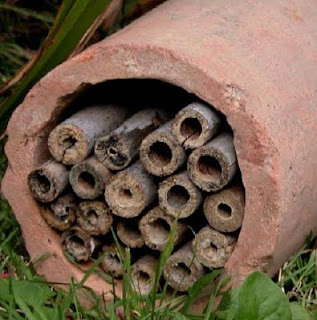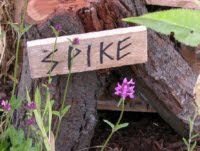Our gardens are home to a wide range of living creatures. An average garden could hold over 2,000 different species of invertebrate. Many of these are very small, so are often over-looked. With all this diversity of life it is good to know that very few creatures cause significant damage to our prized flowers, fruit and vegetables, the ones that gardeners call pests. Even better, there are many more creatures that help us control the pests.
Holes for solitary bees. There are many different
species of solitary bee, all are excellent pollinators. The
female bee lays an egg on top of a mass of pollen at the
end of a hollow tube, she then seals the entrance with a
plug of mud. A long tube can hold several such cells.
Hollow stems, such as old bamboo canes, or holes
drilled into blocks of wood, make good nest sites for
solitary bees. Holes of different diameters mean many
different species can be catered for.
Hedgehogs are loved by most gardeners as the eat many slugs, they also consume earthworms, beetles, spiders, caterpillars, millipedes and woodlice. Hedgehogs need a secure place to build their nests in; a wooden box under a pile of sticks and debris in a sheltered corner is ideal. Our hedgehog home has
dry leaves inside as bedding.
dry leaves inside as bedding.
Frogs and toads eat many slugs and other garden pests. Although they need a pond to breed in, they can spend most of the year out of water. We use stone and tiles as these provide the cool damp conditions amphibians need. Newts may also take advantage of these conditions. Amphibians need a frostfree place to spend the winter; this could be in the centre of our habitat, inside the base of a dry-stone wall, under a pile of rubble or deep underground.








